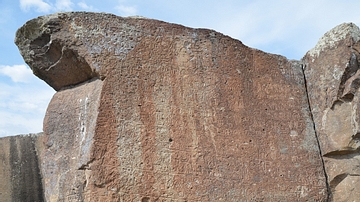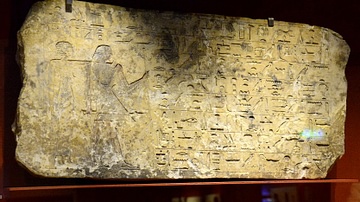Search
Search Results

Video
How Egypt invented the alphabet - History of Writing Systems #7 (Abjad)
From Egyptian hieroglyphs to your alphabet, watch these miners turn fancy symbols into simple scratches that were all about the sounds. First marvel at hieroglyphic inscriptions in the shadow of the great pyramids. Once you grasp how those...

Image
Neo-Hittite Inscription
Neo-Hittite inscription with Luwian hieroglyphs dating back to the 8th century BCE. It is located near Acıgöl in the Nevşehir province in Turkey. It consists of eight lines and commemorates the political and military achievements of King...

Image
Stela of Hetepneb
Brick tomb chapels for the richer members of the society contained stone elements inscribed in hieroglyphics with religious texts to ensure an eternal supply of offerings for the deceased. On this block, the figures of Hetepneb, a local administrator...

Video
The Ancient Egyptian God of Writing and Wisdom, Thoth
Thoth is the ancient Egyptian god of wisdom, magic, writing and the moon and was one of the most important gods of the Egyptian pantheon. As the son of gods representing order and chaos, he was also considered the god of equilibrium which...

Video
Egyptian Scribes
This video explains the detailed roles of Egyptian scribes.

Video
Rosetta Stone, 196 B.C.E
More free lessons at: http://www.khanacademy.org/video?v=OFXY9-pec1I
Rosetta Stone, 196 B.C.E., granite, 114.4 cm x 72.3 x 27.9 cm or 45 x 28.5 x 11 in. (British Museum, London)
Speakers: Dr. Beth Harris and Dr. Steven Zucker

Video
The History of Egypt (Part 2): Decoding Hieroglyphics
How did Egyptologists decipher hieroglyphics? Jean-Francois Champollion started working on decoding the ancient Egyptian writing when he was 9 years old at the end of the eighteenth century. When the Rosetta stone was discovered, he was able...

Video
The Rosetta Stone: What is it and Why is it so Important?
The discovery of the Rosetta Stone unlocked the secrets of Ancient Egypt with the Ancient Greek and Demotic texts being the key to translating the Hieroglyphics for the first time. So, if you want to know what the Rosetta Stone is, why it's...

Video
Ancient Egyptian Language
Here is a video to try to have a better look at what was the ancient Egyptian language,what some letters meant and what different methods of writing were there? Through an imagination trip through time, come with me Nora Hesham to have a...

Video
Cradles of Civilization - Hieroglyphics
Dr. David Neiman discusses the development of hieroglyphs and the use of papyrus and ink in Egypt. Further, he describes how the Phoenicians revolutionized writing with the invention of the alphabet, and that even though the scribes resisted...